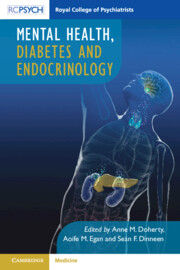Book contents
- Mental Health, Diabetes and Endocrinology
- Mental Health, Diabetes and Endocrinology
- Copyright page
- Contents
- Contributors
- Preface
- Chapter 1 An Introduction to Psychiatry in Endocrinology
- Chapter 2 Depression across Endocrine Disorders
- Chapter 3 Antipsychotic Medications and Metabolic Syndrome
- Chapter 4 ‘Diabulimia’, Diabetes and Eating Disorders
- Chapter 5 Disorders of the Hypothalamic–Pituitary–Adrenal Axis
- Chapter 6 Disorders of the Thyroid and Parathyroid
- Chapter 7 Psychological Factors Impacting on Endocrine Disorders and Self-Management and Medication-Taking Behaviour
- Chapter 8 Cognitive Impairment and Endocrine Conditions
- Chapter 9 Suicidal Ideation and Self-Harm
- Chapter 10 Obesity and Mental Health
- Chapter 11 Gender Incongruence
- Chapter 12 Anti-androgens in Forensic Psychiatric Settings
- Chapter 13 Service- and Setting-Related Challenges
- Index
- References
Chapter 4 - ‘Diabulimia’, Diabetes and Eating Disorders
Published online by Cambridge University Press: 14 October 2021
- Mental Health, Diabetes and Endocrinology
- Mental Health, Diabetes and Endocrinology
- Copyright page
- Contents
- Contributors
- Preface
- Chapter 1 An Introduction to Psychiatry in Endocrinology
- Chapter 2 Depression across Endocrine Disorders
- Chapter 3 Antipsychotic Medications and Metabolic Syndrome
- Chapter 4 ‘Diabulimia’, Diabetes and Eating Disorders
- Chapter 5 Disorders of the Hypothalamic–Pituitary–Adrenal Axis
- Chapter 6 Disorders of the Thyroid and Parathyroid
- Chapter 7 Psychological Factors Impacting on Endocrine Disorders and Self-Management and Medication-Taking Behaviour
- Chapter 8 Cognitive Impairment and Endocrine Conditions
- Chapter 9 Suicidal Ideation and Self-Harm
- Chapter 10 Obesity and Mental Health
- Chapter 11 Gender Incongruence
- Chapter 12 Anti-androgens in Forensic Psychiatric Settings
- Chapter 13 Service- and Setting-Related Challenges
- Index
- References
Summary
Eating disorders, while relatively rare, have the highest mortality rates of all mental disorders. When combined with diabetes, they have poor outcomes in terms of recurrent diabetic ketoacidosis, premature development of microvascular complications and mortality. Eating disorders are common in diabetes and, where present, are associated with a much higher incidence of diabetic complications and a sevenfold increase in mortality. The term ‘diabulimia’ is increasingly used by patient groups and in the general (and social) media. However, it is not a diagnostic term; there has been no professional agreement regarding what constitutes ‘diabulimia’ or what may constitute a minimum set of criteria for diagnosis. It is important for endocrinologists to have a high index of suspicion for eating disorders in patients with diabetes (especially young women with type 1 diabetes). Psychiatrists need to consider and treat insulin omission as a form of purging in eating disorders.
- Type
- Chapter
- Information
- Mental Health, Diabetes and Endocrinology , pp. 31 - 42Publisher: Cambridge University PressPrint publication year: 2021



